Hill of Tara
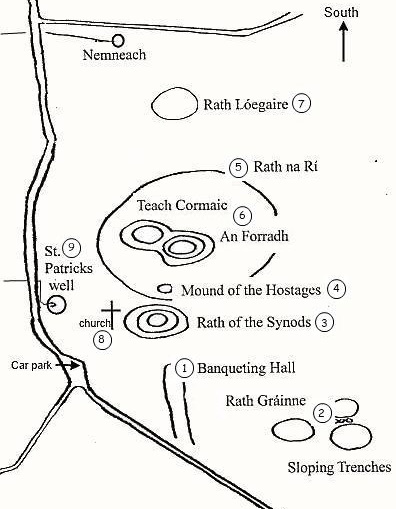 | 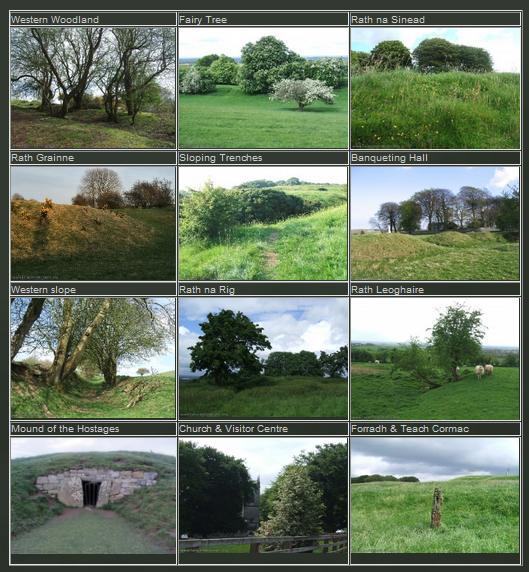 |
Download the map and monument descriptions here
Link here to Samhain at Tara and Tara at Christmas
Arriving on the bus or driving up from the Gabhra valley The Hill
appears as a ridge, just another roll in the landscape, apparently
insignificant in the rise and fall of the surrounding countryside.
Yet, if you hear a call, a desire, a gut feeling, you will follow in the footsteps of our ancestors, climb the gentle hill and discover what you came for. Whatever we hold within ourselves Tara will enlarge, enhance, embolden and clarify. Tara has a child-like quality, no agenda, and will weaken or strengthen you. It will greet you with open arms or push you away for no apparent reason. But it is probable that you will leave knowing that you have had 'an experience', accepted or rejected.
The energies are often seen as yellow and maybe it is no coincidence that part of the area is known as Castleboy (boy = bui = yellow). Yellow, the colour of the 3rd chakra, the solar plexus, your 'will-power'.
The name Tara and most of the names of monuments on The Hill, and Ireland generally, come from oral history, recorded in a series of books called the Metrical Dindshenchas. Tara is the 1st volume. It starts:
Temair Breg, whence is it named? declare O sages!
when did the name part from the stead?
when did Temair become Temair?
Was it under Partholan of the battles?
or at the first conquest by Cesair?
or under Nemed of the stark valour?
or under Cigal of the knocking knees?
Was it under the Firbolgs of the boats?
or from the line of the Lupracauns?
tell which conquest of these it was
from which the name Temair was set on Temair?
1 Banqueting Hall
Teach Miodhchuarta (Mead Circling House). This was possibly the ceremonial entrance ontoTara, where the roads to the Hill met. A linear earthwork, either Bronze or Iron Age, usually identified as a cursus. It rises up the hillside north-south. The name suggests that it is where the legendary Ard Ri (High King) feasted. A Medieval text shows a seating plan of the Great Hall, however, a feasting room in ancient days is more likely to have been a Round House.
Legend has it that Cessair, grand daughter of Noah, came with a ship of 50 women and 3 men. They were the first humans to set foot there. This is the nearest Ireland get to a creation myth. One of the names of the Banqueting Hall - Teach-Miodhehuarta - is Ship of the Women - long na mban... However, the flood covers Ireland and Cessair and all the women, along with two of the men, are drowned. Fintan is the sole survivor. He survives by changing into a salmon, and then an eagle, and finally a hawk, before eventually resuming his own shape.
2 Rath Grainne & Sloping Trenches
Three circular earthworks on the north west side of the Hill. Rath Grainne is a bank and ditch with a central mound.
According to the writings of medieval monks, Grainne was the daughter of Cormac MacArt an Ard Ri from around 200AD. In the Chronicles of Clonmacnoise he is described as ‘the best king that ever reigned before himself’ being ‘wise, learned, valiant and mild’. He is said to have been responsible for compiling many of the Brehon Laws. However, the love story of The Pursuit of Diarmuid and Grainne reveals the restraints that come with Kingship, when social requirements place restrictions on a Royal family. The story may be symbolic of the movements and alignments of sun, moon and stars when related to places the lovers visit on their flight across Ireland.
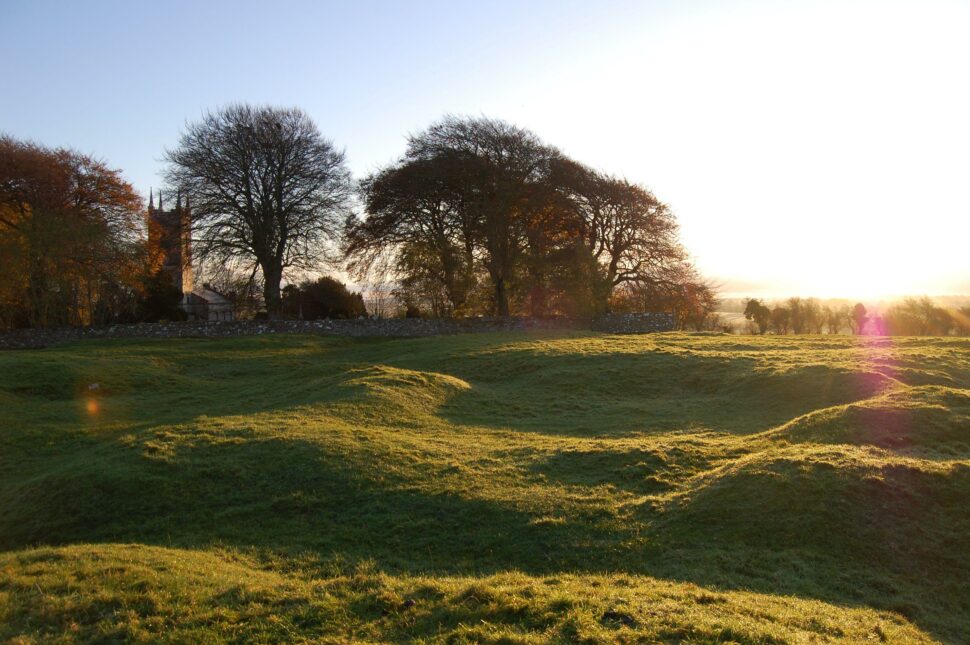
3 Rath of the Synods
Difficult to identify the layout following the 1890's ‘excavation’ by British Israelites searching for the Arc of the Covenant. Geophysical surveys revealed a large circle of over 300 huge posts, probably oak, on this eastern side of the Hill. Roman artefacts have been found here and the area appears to have been in greatest use between 100AD to 300AD. It is the reputed site of Synods held by St. Patrick and succeeding Church leaders.
4 Mound of the Hostages
Known in Irish as Duma na nGiall. Dating from 5000 years ago a wooden palisade enclosure underlies this passage grave. Contemporary with Newgrange. The passage faces eastwards, aligned with Samhain & Imbolc sunrise, with a decorated stone just inside the entrance on the left. The mound was used for burials from the early Neolithic up to 1600 - 1700 BCE. There are an estimated 250 – 500 people interred here. Cremation was the early method, ashes and grave goods spread on the floor of the tomb. In the Bronze Age, as the passage filled up, the bodies were placed in the mound. Over 40 remains have been found in inverted cinerary urns.The full skeleton of a Bronze Age youth was also discovered in a crouched position in a simple pit. Known as Tara Boy, the grave goods found with the body include a decorated bead necklace and bronze knife.
5 Rath na Ri
Contained within the large earthwork of Rath na Ri are ditch enclosures Teach Cormaic and the Forradh. Rath na Ri changed use from being a ‘ritual’ site in the Late Bronze Age to a defensive structure.
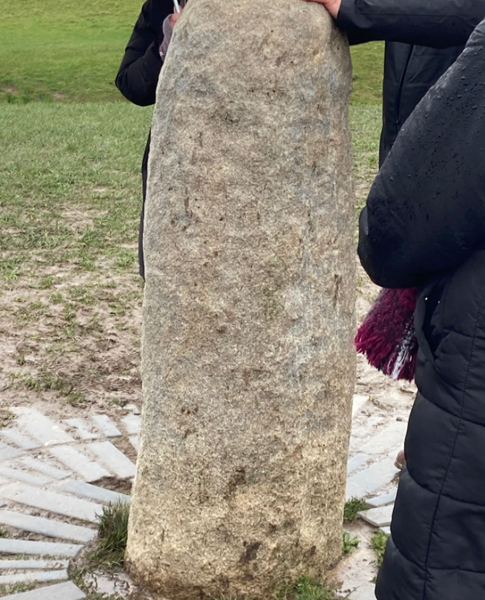
6 Teach Cormac and the Forradh
These are linked together but, the Forradh (or Royal Seat) is the older site. The Forradh has two banks and ditches.
Lia Fail - On the height of the Forradh is the white granite Lia Fail (Stone of Destiny) said to be the stone of kingship which roared when touched by the suitable candidate.
When the legendary Tuatha de Danaan came to Ireland this was one of the four sacred symbols they carried. The others being the sword of Nuada – also described as a glowing bright torch, the spear of Lug and a cauldron of the good god Dagda that was never empty.
7 Rath Leogaire
A Late Bronze Age ringfort. This name recalls the Ard Ri who allowed his followers conversion to Christianity by St. Patrick after 433AD. Following this Tara gradually became more secular than sacred. In the Books of Ballymote and Armagh Loegaire is said to be buried standing up facing south, accompanied by his weapons and in warrior dress, watching for enemies. South of Rath Loegaire is the spring, Nemnach, said to be the site of the first Mill in Ireland.
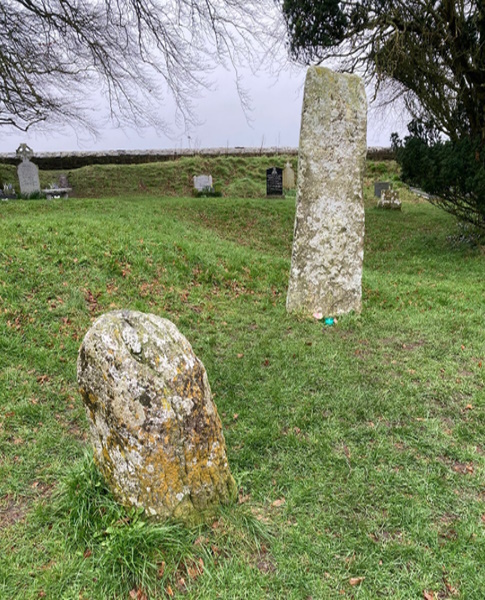
8 St Patrick's Churchyard
Mixed Roman Catholic & Church of Ireland burials. The church was restored in the mid-1800s and deconsecrated in the late 1900s.
At the start of the Norman rule in Ireland in the 1100’s, the church was connected with the Knights Hospitallers of Saint John of Jerusalem of Kilmainham in Dublin. The primary purpose of the Order was to provide refreshment to pilgrims and travellers. The Knights had to show proof of nobility, make payments to the Order and maintain themselves and two horses. On death all their property was left to the Order.
On the south west side of the church, a wall from the old buildings is next to two upright stones. These stones may have been taken from the old church, or they may be two of the many standing stones that reportedly once stood on Tara. Both are identified by some as Blocc and Bluigne, and one is often called Adamnan’s Pillar. On Adamnan’s Pillar is a carving said to be a sheela-na-gig, or maybe it is Cernunnos, the horned Celtic God.
Scene of a bloody battle between Irish and British / European in 1798 during the Croppy Boy rebellion, it is a place in which to pay respect to our ancestors.
9 St Patrick's Well,
also known as Bo Finne, Well of the Dark Eye, Well of the Numbering of the Clans
| Gon-éirí an bóthar leat. Go raibh cóir na gaoithe igcónaí leat. Go dtaitní an ghrian go bog bláth ar do chláréadain, go dtite an bháisteach go bog mín ar do ghoirt. Agusgo gcasfar le chéile sinn arís, go gcoinní Dia i mbois a láimhethú. | May the road rise to meet you. May the wind be always at your back. May the sun shine warm upon your face, the rain fall soft upon your fields. And until we meet again, may God hold you in the palm of his hand |
10 Faery Tree
On the western facing slopes stands the faery tree. In the late 2010's it started to show signs of struggling to survive, the trunk splitting, one half collapsing to the ground. Read more of what happened next at Faery Tree - Hill of Tara





